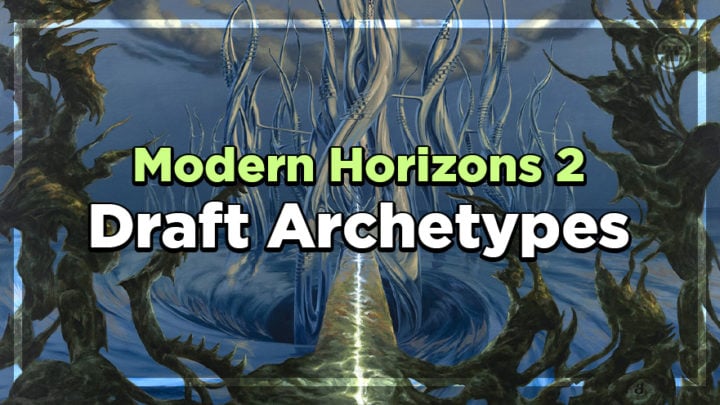The glamorous and much-discussed new Modern Horizons 2 is out in the wild this week, and players have rushed to celebrate its high-powered and exciting draft environment.
The special charm of these Modern Horizons sets comes from WotC’s stated willingness to put aside many of their self-imposed rules for set design. By unleashing their wildest and most challenging card ideas — and reintroducing a variety of old set mechanics at once — they’ve created a draft environment closer to a typical Cube, but with almost entirely new cards for us to evaluate!
Despite the lack of mechanical focus in MH2, there are still broad lanes of synergy you can align your draft with — and key role-players within each one which tie them all together. You won’t necessarily get a deck that lands exactly within one of these archetypes or even within one color pair. But understanding what they are and where they intersect will help guide you into a more consistent pile at the end.
White-Blue: Artifact Value
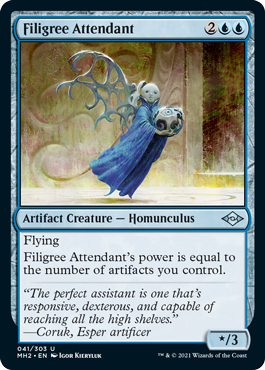
These colors share the broad theme of “having artifact permanents is good” — and generally, the more you have, the better. Getting artifacts isn’t hard — not only are 50% of white’s creatures and blue’s tokens artifact creatures, but the overall focus on artifact tokens (and complementary red artifact theme) mean there should be plenty to splash for even if you find this archetype contested. Your payoffs for having a hoard of artifacts come in the form of “affinity for artifacts” cards: one of a few legendary mechanics WotC let out of the vault for this set.
Playing this deck is as forgiving as assembling it. Getting to play your large affinity creatures for cheap or free is never bad, and the gold spells each emphasize the “overwhelming value” approach by immediately digging you to your next artifact card. The most important part of drafting this deck is securing a high density of mana-efficient artifacts to kickstart your stockpile each game — keep an eye out for the new artifact dual lands, especially those in your colors!
But you can also look to secure a couple of uncommon win-cons like Caprichrome, Filigree Attendant or Extruder. The latter two in particular allow you to instantly convert a pile of random artifacts into lethal damage with almost no warning!
Green-White: +1/+1 Counters
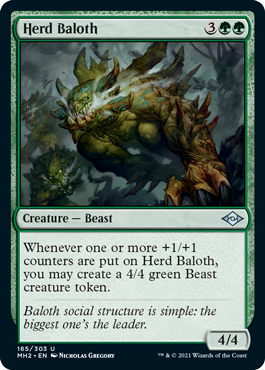
The diverse nature of MH2 card design meant WotC needed these archetypes to be very broad umbrellas, centered on evergreen design themes like “artifacts” and “the graveyard.” Luckily, the sheer density of +1/+1 counter mechanics from the last two decades give G/W an easy identity in MH2.
One twist on this theme is that most of your key cards get their power from triggers whenever +1/+1 counters are added to them. It’s not necessarily about stacking up the biggest creature you can, although giant threats can be a game plan unto themselves. Herd Baloth in particular packs the power you’d expect from top rares in Standard sets, with Scurry Oak, Constable of the Realm and Knighted Myr not far behind.
Making full use of these triggers requires some way to add counters at instant speed and low mana cost, making Unbounded Potential, Bannerhide Krushok and even Break Ties top priority commons. But in general, you’ll be trying to maximize the amount of “incidental” counters in your deck. Smell Fear and the endearingly-named Captured by Lagacs are great removal spells — and as a bonus, they’ll produce some counters for you!
The white modular creatures can be a little more risky, since you can only move their counters onto other artifact creatures. Monoskelion is already a high-tier pick in this deck, but is made even more important as your ideal target for these effects if you draft them.
Red-White: Artifact Aggro
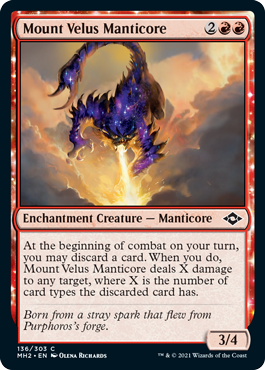
Boros colors are back in their familiar beatdown role for MH2, serving as both “the other artifact deck” and “the other counters deck.” This means that starting out with white-red and some colorless artifact creatures allows you to easily branch into synergistic white-red-green or white-red-blue decks as the draft evolves – perhaps even mixing all four colors if you can snare enough artifact taplands! While WotC has stated that all MH2’s archetypes were designed to overlap in shared colors, a few specific combinations, like this one, demonstrate much stronger synergy.
To maximize the power of this archetype, you’ll want to secure as many modular creatures as possible early in the draft. While these are mostly common, the white ones in particular will be sought after by anyone in that color; you shouldn’t be too hopeful of wheeling them. Red’s modular bodies are significantly more expensive, but should be easier to pick up, ensuring you’ll never run out of places to put your counters. And of course, both R/W gold cards are tremendous here.
Otherwise, prioritize white’s artifact and counters synergies, while treating red as a toolbox full of whatever support your deck ends up needing. Working in more of the +1/+1 counter synergies from green? Flametongue Yearling is a great pickup. Strike It Rich and Tavern Scoundrel offer fixing for your third color while spinning off a couple cheap artifacts to help out any U/W cards you grab. Mount Velus Manticore gets a special shout-out for its slightly more subtle synergy with artifact creatures; in fact, this quirk raises the value of all delirium cards in this deck, particularly Unholy Heat.
Blue-Green: Tokens
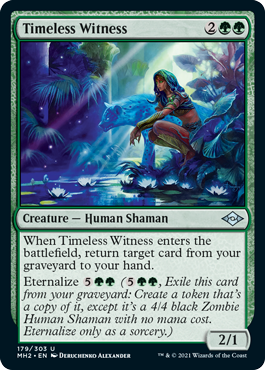
Completing this “top left” color pie quadrant of connected draft archetypes, U/G ignores its traditional Limited theme of “ramp” and instead focuses on generating tons of tokens. However, this is not quite your traditional go-wide creature token strategy; if anything, that role is filled in MH2 by B/G Squirrels. Instead, this archetype dovetails nicely with the U/W “artifact value” theme by spitting out tons of Treasures, Clues and Food alongside the occasional creature token.
The most important thing to keep in mind here is that, in Limited, stockpiling these “resource tokens” can be a game plan unto itself! U/G has clearly been positioned among the late game, grindy decks of the format with cards like Timeless Witness, Combine Chrysalis and Fae Offering. Don’t feel pressured to prioritize “payoffs” like Glimmer Bairn; just focusing on card quality and battlefield control will get you where you need to go.
The focus on incremental value means that your “engine piece” uncommons are hugely influential on how exactly you draft this archetype. Junk Winder, Etherium Spinner and Combine Chrysalis are hard to go wrong with, but unlocking Herd Baloth and Deepwood Denizen requires you to seek out extra +1/+1 counters support, perhaps dipping into white as you do. Blue options like Scuttletide and Raving Visionary offer more of a bridge between this deck and the opposite quadrant – centered around red, black, and filling your graveyard.
Black-Red: Madness
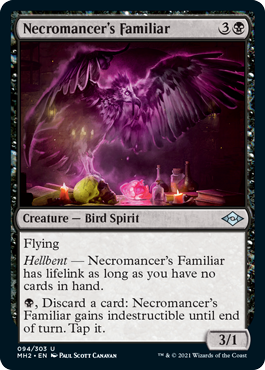
The graveyard themes running through the blue, black and red cards of MH2 find their most obvious payoff in red-black’s madness mechanic. Since discarding your own cards almost always comes at a cost, being able to use the discarded card as well as the effect it’s paying for yields an immediate resource advantage. The biggest hurdle here is finding enough good discard outlets to enable the deck. Ideally, these outlets allow you to discard at instant speed and for little mana, since you still need to be able to pay your madness costs on top of activating them.
Clearly, the designers of MH2 were dead-set on making this archetype viable, because they were extremely generous in including these vital enablers. Necromancer’s Familiar, The Underworld Cookbook and Mount Velus Manticore help shore up your board and life total while you sculpt your hand and graveyard. Skirge Familiar and Patchwork Gnomes show up in the reprint booster slot, while Hell Mongrel, Cabal Initiate and Viashino Lashclaw provide extra redundancy at common.
Fodder Tosser is by far the worst of the lot due to its minimal board impact. Given that we also have one-off enablers like Faithless Salvaging and further options in blue, I’d be hesitant to ever draft this as an enabler. If anything, this card affords us a backup win condition if we can’t find Feast of Sanity or the aforementioned Manticore.
Getting as many madness spells as you can and a few of these discard outlets is a strong start, but to really do well in R/B, you’ll want some ways to refill your hand, too. Madness generates mana advantage or “tempo,” letting you put more cards into play faster, and a couple of cards here power up when your hand is empty. But in general, running out of spells is the best way to lose at Limited — so, as odd as it sounds, I would regard Clattering Augur, Echoing Return, Gilt-Blade Prowler and Greed as perhaps the most indispensable cards for this archetype if you aren’t splashing.
Blue-Black: SURVEIL (AND SELF-DISCARD)

U/B is perhaps the most nebulous color pair in terms of identity, with the baffling designation “self-discard matters.” In practice, this is less a result of U/B having specific payoffs for its discard or surveil effects, and more about these colors being surrounded by different graveyard synergies in W/B, U/R, and R/B. As with R/W, this broad overlap makes it easy to lock in U/B at the start of the draft and then use its generic graveyard manipulation to set up whatever third color comes your way.
I should clarify that it seems perfectly viable to stick in U/B without any splash. You can put together in-color graveyard payoffs like Archfiend of Sorrows, Tizerus Charger, Lucid Dreams and Young Necromancer, and there’s enough overlap with the delirium and madness cards to just throw in things like Raving Visionary and Mystic Redaction.
Like U/G, going this route essentially sets you up to play generic “good stuff control,” so avoid playing the “risky” madness/delirium cards and prioritize bombs, removal and value like Said // Done that will help grind opponents into dust.
Blue-Red: Delirium

I can’t stress enough how similarly these last three color pairs play, or how much overlap there is between the cards they want to prioritize. In fact, it’s probably more useful to think of the archetype as “Grixis Delirium” and view the individual madness spells or graveyard payoffs as interchangeable tools that your discard engine can utilize.
With that in mind, the biggest question to ask yourself when you start drafting in Grixis colors is about tempo. Are you trying to create an overwhelming early curve with discounted madness creatures? Or are you going to play a long game, combining looting, madness and recursion to squeeze multiple uses out of each card?
I think the latter approach is better supported. Past draft formats have proved the effectiveness of non-combat threats like Feast of Sanity and Mystic Redaction, and the concentration of resource-intensive draw engines like Clattering Augur, Gilt-Blade Prowler and Raving Visionary pushes this strategy over the top. Clog the board, conserve your spells, and grind them out.
White-Black: REANIMATOR
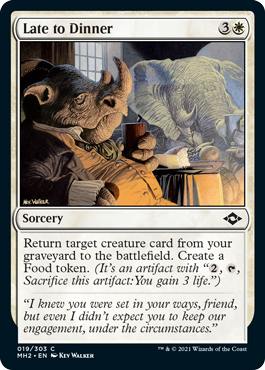
Okay, onto the last three archetypes, which stand out to me as slightly less connected than the two “quadrants” of synergy we’ve explored so far. That’s not to say that the W/B mechanics can’t be combined with the artifact/counters/aggro or madness/delirium/recursion piles — more that there’s less of a clear reason to prefer one over the other. Reanimator is less dependent on specific setups and payoffs compared to other strategies; you’ll always be playing and losing creatures in a game of Limited, and bringing the best ones back over and over is always going to put you ahead.
Late to Dinner is your common reanimation effect (appearing in white, for once), while Young Necromancer and Graceful Restoration back it up at uncommon. And don’t overlook Scour the Desert as a different take on “reanimation.” How many copies of these spells you can secure in the draft is the difference between a generic WBx deck and something focused enough to warrant the “reanimator” label.
As in Ikoria draft, you can get away with these effects in a “normal” creature deck thanks to cycling creatures, which provide big bodies in the graveyard without requiring low-tempo setup cards like Sinister Starfish and Vile Entomber. Orchard Strider does represent a meaningful incentive to go into green, but you can get away with just Landscaper Colos and Sojourner’s Companion, perhaps backed up by some red discard enablers. As an aside, remember that casting madness creatures will not trigger the W/B gold card Breathless Knight, as it’s technically being cast from exile en route to your yard.
If you go the other direction and play with the Grixis quadrant, all bets are off. You’re most likely splashing white in this case, using Late to Dinner to get repeated uses out of the rares and bombs you’re aggressively discarding.
But there’s also a third option. While not as obvious as the decks we’ve touched on, the combination of white-black-green-blue is another possible combination to explore, centered on recycling cards, sacrificing, and creature tokens. This route lets us expand our W/B picks to include value-driven recursion like Abiding Grace or Disciple of the Sun, as well as token-making reanimation targets Soul of Migration and Underworld Hermit.
Black-Green: SQUIRREL TOKENS

“Mad Mark” Rosewater has finally gotten his way, and Squirrel tribal is back to dominate the once-too-serious realm of black-bordered Magic! R&D made certain to absolutely juice the power level on these cards, and depending on the rares you find, the dedicated Squirrel deck will easily bully your draft pod. But even if you don’t high-roll your way into something like Chatterfang plus Chitterspitter, the sheer weight of bodies created by Chatterstorm and Scurry Oak can still open up a strong “Aristocrats”-style game plan.
Glimmer Bairn, Nested Shambler and Ravenous Squirrel are all incredibly threatening one-drops to any slow-moving Grixis deck, while Squirrel Sovereign helps milk maximum damage out of your tokens before you sacrifice them for the final blow. You can add in more madness and discard effects to turn up the early pressure even more, or add white recursion – particularly Abiding Grace – and play the value game with Squirrel Sanctuary and Legion Vanguard, finishing with chip from Vermin Gorger and Sanctuary Raptor or an overwhelming army of tokens pumped by Drey Keeper.
The latter build in particular overlaps pretty heavily with the grindy artifact token focus of U/G, giving you another viable splash color to consider.
Red-Green: Storm

This final color pair, opposite U/B on the color pie, seems to be filling a similar supporting role. Yes, there are actual, factual storm payoffs in the set, most notably Chatterstorm and Spreading Insurrection. Hunting Pack is expensive enough that it will play more like a trap for opposing players taking big turns than something you try to go off with, and Galvanic Relay is more enabler than payoff. Instead, your “storm” deck will be trying to get incremental value from Arcbound Tracker or Captain Ripley Vance, which will discourage any attempt to build the rickety, all-in combo pile that Limited storm usually becomes.
That being the case, I’m not certain what would draw someone to play a dedicated R/G deck – but I do see the color pair as vital to the “bonus” archetype of Five-Color Converge. R/G has all the fixing and all the ramp you need to make five colors of mana work, as well as two of the most threatening payoffs in Kaleidoscorch and Glinting Creeper (plus Territorial Kavu at rare).
Approaching the color pair this way actually gives us a more satisfying perspective on the storm subtheme, too. Rather than setting out to win the game off an enormous Chatterstorm or Hunting Pack, those cards give us an extra way to weaponize the “air” we’re forced to include in a five-color deck. Should your draw end up with too much fixing and not enough payoff, you can hold those surplus spells in hand and then burn them off all at once to fuel a lethal horde of Squirrels!
A MODERN DRAFTING MASTERPIECE
So, that’s the tangled spider web (Squirrel web?) of Modern Horizons 2 draft. Despite the surface appearance of neat, two-color archetypes, the set’s broad and overlapping mechanical themes mean that, in practice, most decks will likely be three colors, or at least two with a splash. It’s interesting to see how those combinations naturally fall into two or three macro-archetypes, which makes it extremely nerve-wracking to try and wheel key pieces past players in adjacent colors. Overall, this set presents a multifaceted, challenging, and choice-rich draft experience — perfectly on-brand for a Modern Horizons set.

Tom’s fate was sealed in 7th grade when his friend lent him a pile of commons to play Magic. He quickly picked up Boros and Orzhov decks in Ravnica block and has remained a staunch white magician ever since. A fan of all Constructed formats, he enjoys studying the history of the tournament meta. He specializes in midrange decks, especially Death & Taxes and Martyr Proc. One day, he swears he will win an MCQ with Evershrike. Ask him how at @AWanderingBard, or watch him stream Magic at twitch.tv/TheWanderingBard.

